Research Proposal: Nuclear Power Plant Safety in the UAE
VerifiedAdded on 2022/10/06
|22
|5672
|19
Report
AI Summary
This research proposal investigates the effects of safety culture and ethical leadership on the safety performance of nuclear power plants, specifically in the United Arab Emirates. The study aims to address the critical concerns surrounding nuclear power plant safety, especially in light of incidents like Chernobyl and Fukushima. The research will explore the current knowledge of safety issues, including natural hazards, nuclear waste management, and security concerns. The proposal outlines the research approach, including the research design, methodology, and data analysis procedures. It also includes a detailed project plan, timetable, and resource requirements. The study's limitations and assumptions are clearly defined, emphasizing the importance of this research in ensuring the safe and sustainable use of nuclear energy as an alternative power source. The literature review examines existing studies on safety culture, ethical leadership, and their impact on industrial safety. The research seeks to contribute to a better understanding of how to enhance the safety performance of nuclear power plants.
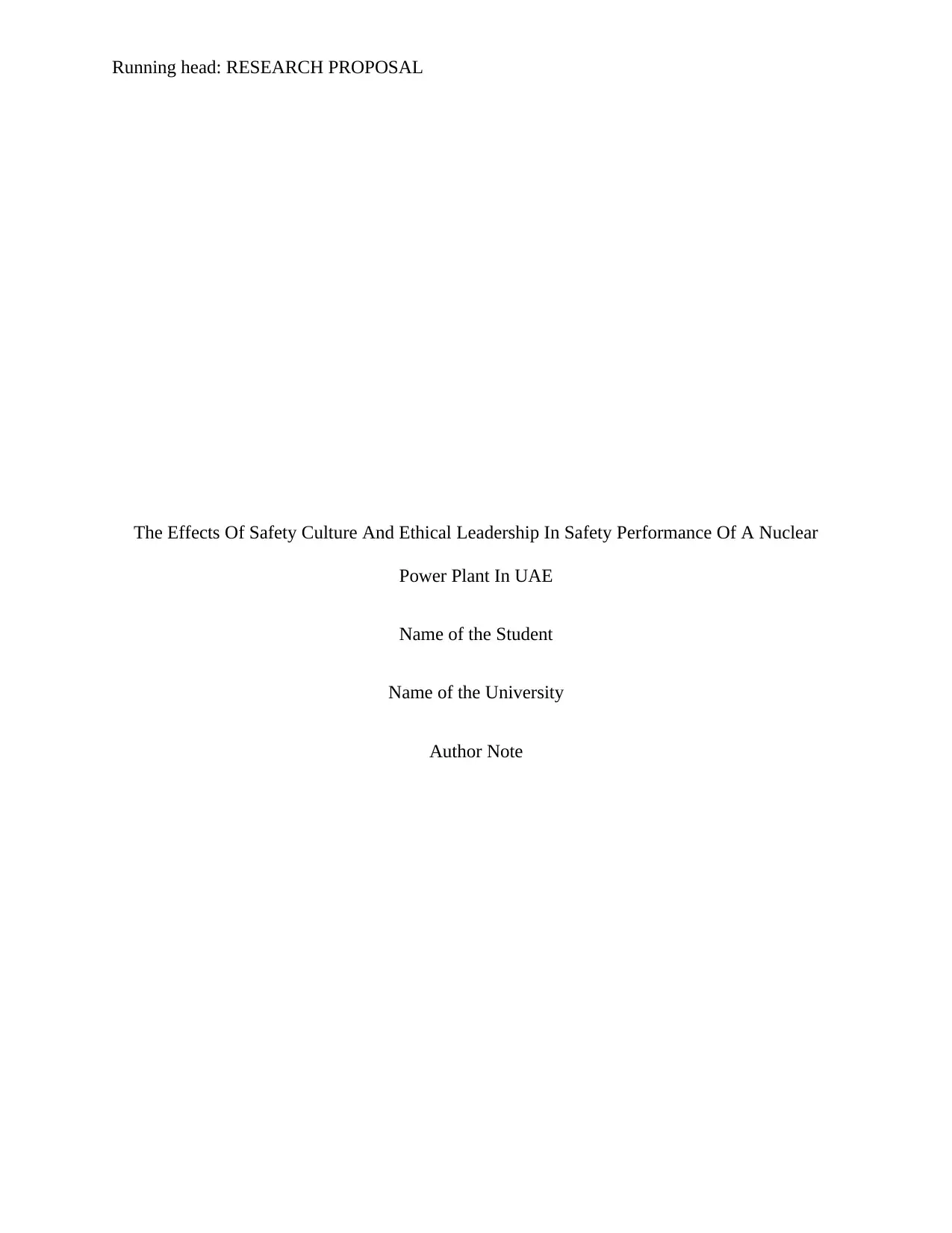
Running head: RESEARCH PROPOSAL
The Effects Of Safety Culture And Ethical Leadership In Safety Performance Of A Nuclear
Power Plant In UAE
Name of the Student
Name of the University
Author Note
The Effects Of Safety Culture And Ethical Leadership In Safety Performance Of A Nuclear
Power Plant In UAE
Name of the Student
Name of the University
Author Note
Paraphrase This Document
Need a fresh take? Get an instant paraphrase of this document with our AI Paraphraser
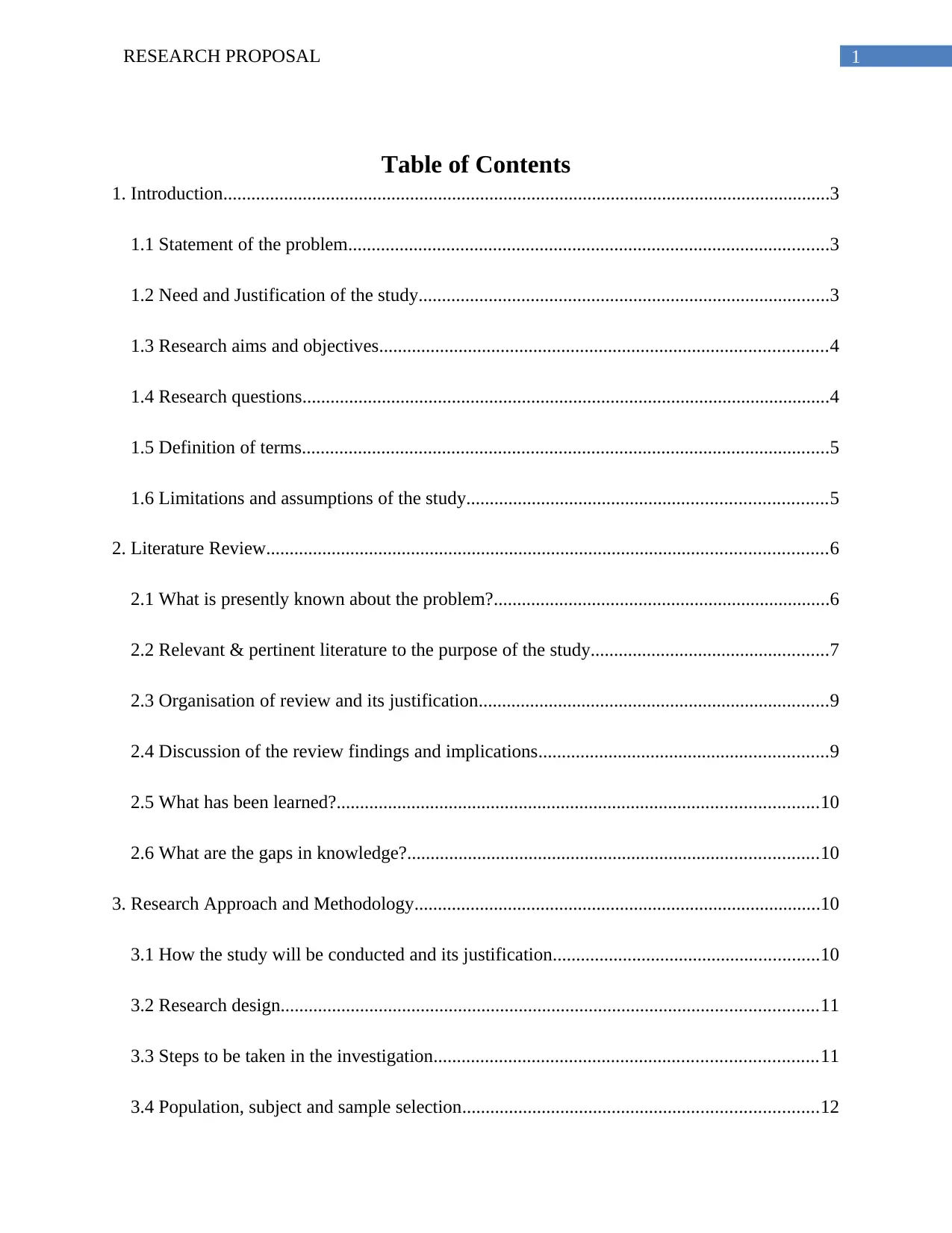
1RESEARCH PROPOSAL
Table of Contents
1. Introduction..................................................................................................................................3
1.1 Statement of the problem.......................................................................................................3
1.2 Need and Justification of the study........................................................................................3
1.3 Research aims and objectives................................................................................................4
1.4 Research questions.................................................................................................................4
1.5 Definition of terms.................................................................................................................5
1.6 Limitations and assumptions of the study.............................................................................5
2. Literature Review........................................................................................................................6
2.1 What is presently known about the problem?........................................................................6
2.2 Relevant & pertinent literature to the purpose of the study...................................................7
2.3 Organisation of review and its justification...........................................................................9
2.4 Discussion of the review findings and implications..............................................................9
2.5 What has been learned?.......................................................................................................10
2.6 What are the gaps in knowledge?........................................................................................10
3. Research Approach and Methodology.......................................................................................10
3.1 How the study will be conducted and its justification.........................................................10
3.2 Research design...................................................................................................................11
3.3 Steps to be taken in the investigation..................................................................................11
3.4 Population, subject and sample selection............................................................................12
Table of Contents
1. Introduction..................................................................................................................................3
1.1 Statement of the problem.......................................................................................................3
1.2 Need and Justification of the study........................................................................................3
1.3 Research aims and objectives................................................................................................4
1.4 Research questions.................................................................................................................4
1.5 Definition of terms.................................................................................................................5
1.6 Limitations and assumptions of the study.............................................................................5
2. Literature Review........................................................................................................................6
2.1 What is presently known about the problem?........................................................................6
2.2 Relevant & pertinent literature to the purpose of the study...................................................7
2.3 Organisation of review and its justification...........................................................................9
2.4 Discussion of the review findings and implications..............................................................9
2.5 What has been learned?.......................................................................................................10
2.6 What are the gaps in knowledge?........................................................................................10
3. Research Approach and Methodology.......................................................................................10
3.1 How the study will be conducted and its justification.........................................................10
3.2 Research design...................................................................................................................11
3.3 Steps to be taken in the investigation..................................................................................11
3.4 Population, subject and sample selection............................................................................12

2RESEARCH PROPOSAL
3.5 Methods to be used – how and why.....................................................................................12
3.6 Ethical issues and procedures..............................................................................................13
3.7 Measures of outcome...........................................................................................................13
3.8 Procedure for data analysis..................................................................................................13
4. Project Plan, Timetable Schedule..............................................................................................14
4.1 Subject selection..................................................................................................................14
4.2 Approval of subjects and other issues.................................................................................14
4.3 Data collection.....................................................................................................................14
4.4 Data analysis........................................................................................................................14
4.5 Work plan............................................................................................................................15
4.6 Resource requirements.........................................................................................................16
References......................................................................................................................................17
3.5 Methods to be used – how and why.....................................................................................12
3.6 Ethical issues and procedures..............................................................................................13
3.7 Measures of outcome...........................................................................................................13
3.8 Procedure for data analysis..................................................................................................13
4. Project Plan, Timetable Schedule..............................................................................................14
4.1 Subject selection..................................................................................................................14
4.2 Approval of subjects and other issues.................................................................................14
4.3 Data collection.....................................................................................................................14
4.4 Data analysis........................................................................................................................14
4.5 Work plan............................................................................................................................15
4.6 Resource requirements.........................................................................................................16
References......................................................................................................................................17
⊘ This is a preview!⊘
Do you want full access?
Subscribe today to unlock all pages.

Trusted by 1+ million students worldwide

3RESEARCH PROPOSAL
1. Introduction
1.1 Statement of the problem
From the Fukushima incident and the explosion at Chernobyl at Ukraine, the safety
performance of the nuclear power plants has become one of the most sensitive concerns (Matsuki
& Bidyuk, 2016). Researchers has made enough research regarding the factors that influence the
safety performance of the nuclear power plants. The primary issues regarding the safety of a
nuclear power plant are its effects towards the environment, physical features and natural hazards
(Yu et al., 2017). The destructive nature of the effects makes the nuclear power plants a
concerning issue. Hence, it is an important factor be researched on so that the safety performance
of the nuclear power plants can be enhanced and this alternative source of power can be used in
the future without being scared of it.
1.2 Need and Justification of the study
The safety performance of the nuclear power plants is an important parameter based on
which the future of this alternative source of power depends on (Schöbel et al., 2017). It is
certain that in finding an alternative source of energy has become an inevitable aspect for the
entire planet. Researches reveal the statistics of the depletion of the resources and the result
seems to be dangerous for the future generations. Statistics reveal that coal extraction for peat
coal will be done by the year 2048 starting from 2025 and the supply for the resources will
sustain for the next 198 years (Feng et al., 2019). In case the usage increase then this span will
decrease accordingly as well. Same situation prevails for oil and natural gas as well. There is a
reserve of 198.2 million tons of oil that can supply this planet for the next 46.2 years and reserve
for the natural gas will supply for the next 59 years (Kuhns & Shaw, 2019). All of these
1. Introduction
1.1 Statement of the problem
From the Fukushima incident and the explosion at Chernobyl at Ukraine, the safety
performance of the nuclear power plants has become one of the most sensitive concerns (Matsuki
& Bidyuk, 2016). Researchers has made enough research regarding the factors that influence the
safety performance of the nuclear power plants. The primary issues regarding the safety of a
nuclear power plant are its effects towards the environment, physical features and natural hazards
(Yu et al., 2017). The destructive nature of the effects makes the nuclear power plants a
concerning issue. Hence, it is an important factor be researched on so that the safety performance
of the nuclear power plants can be enhanced and this alternative source of power can be used in
the future without being scared of it.
1.2 Need and Justification of the study
The safety performance of the nuclear power plants is an important parameter based on
which the future of this alternative source of power depends on (Schöbel et al., 2017). It is
certain that in finding an alternative source of energy has become an inevitable aspect for the
entire planet. Researches reveal the statistics of the depletion of the resources and the result
seems to be dangerous for the future generations. Statistics reveal that coal extraction for peat
coal will be done by the year 2048 starting from 2025 and the supply for the resources will
sustain for the next 198 years (Feng et al., 2019). In case the usage increase then this span will
decrease accordingly as well. Same situation prevails for oil and natural gas as well. There is a
reserve of 198.2 million tons of oil that can supply this planet for the next 46.2 years and reserve
for the natural gas will supply for the next 59 years (Kuhns & Shaw, 2019). All of these
Paraphrase This Document
Need a fresh take? Get an instant paraphrase of this document with our AI Paraphraser
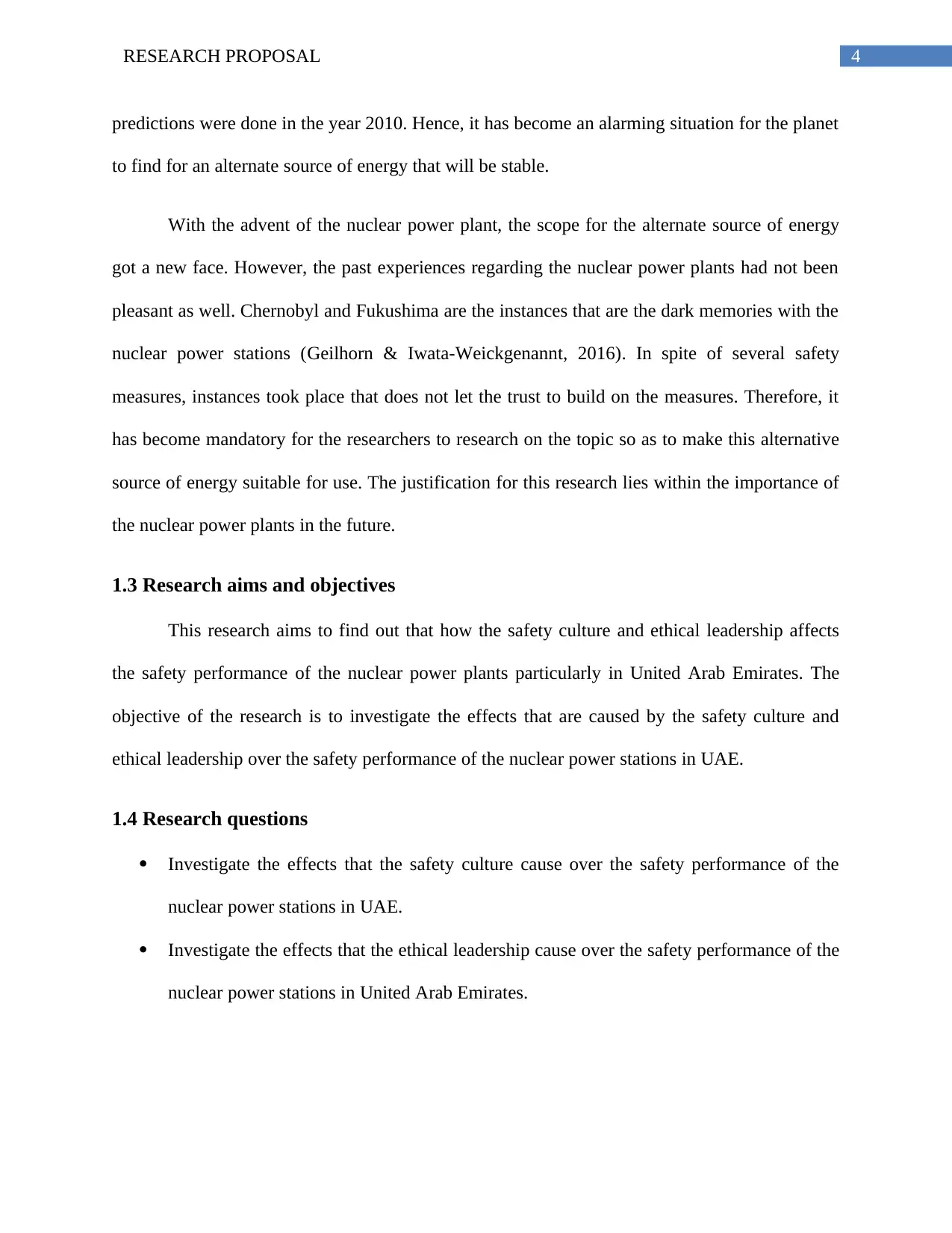
4RESEARCH PROPOSAL
predictions were done in the year 2010. Hence, it has become an alarming situation for the planet
to find for an alternate source of energy that will be stable.
With the advent of the nuclear power plant, the scope for the alternate source of energy
got a new face. However, the past experiences regarding the nuclear power plants had not been
pleasant as well. Chernobyl and Fukushima are the instances that are the dark memories with the
nuclear power stations (Geilhorn & Iwata-Weickgenannt, 2016). In spite of several safety
measures, instances took place that does not let the trust to build on the measures. Therefore, it
has become mandatory for the researchers to research on the topic so as to make this alternative
source of energy suitable for use. The justification for this research lies within the importance of
the nuclear power plants in the future.
1.3 Research aims and objectives
This research aims to find out that how the safety culture and ethical leadership affects
the safety performance of the nuclear power plants particularly in United Arab Emirates. The
objective of the research is to investigate the effects that are caused by the safety culture and
ethical leadership over the safety performance of the nuclear power stations in UAE.
1.4 Research questions
Investigate the effects that the safety culture cause over the safety performance of the
nuclear power stations in UAE.
Investigate the effects that the ethical leadership cause over the safety performance of the
nuclear power stations in United Arab Emirates.
predictions were done in the year 2010. Hence, it has become an alarming situation for the planet
to find for an alternate source of energy that will be stable.
With the advent of the nuclear power plant, the scope for the alternate source of energy
got a new face. However, the past experiences regarding the nuclear power plants had not been
pleasant as well. Chernobyl and Fukushima are the instances that are the dark memories with the
nuclear power stations (Geilhorn & Iwata-Weickgenannt, 2016). In spite of several safety
measures, instances took place that does not let the trust to build on the measures. Therefore, it
has become mandatory for the researchers to research on the topic so as to make this alternative
source of energy suitable for use. The justification for this research lies within the importance of
the nuclear power plants in the future.
1.3 Research aims and objectives
This research aims to find out that how the safety culture and ethical leadership affects
the safety performance of the nuclear power plants particularly in United Arab Emirates. The
objective of the research is to investigate the effects that are caused by the safety culture and
ethical leadership over the safety performance of the nuclear power stations in UAE.
1.4 Research questions
Investigate the effects that the safety culture cause over the safety performance of the
nuclear power stations in UAE.
Investigate the effects that the ethical leadership cause over the safety performance of the
nuclear power stations in United Arab Emirates.

5RESEARCH PROPOSAL
1.5 Definition of terms
There are three primary terms that need to be defined before getting into the details of the
research. They are as follows:
Safety Culture: Safety culture can be defined as a set or collection of values, beliefs and
perceptions that are shared by the employees regarding the risks that are associated with an
organisation such as a community or a workplace (van Nunen et al., 2019).
Ethical Leadership: Ethical leadership is the kind of leadership that gets its direction by the
values and the beliefs that are ethical in nature and respects the right and dignity of others. In
other words the concept of ethical leadership related to other concepts such as honesty, fairness,
consideration, trust and so on (Bedi, Alpaslan & Green 2016).
Safety Performance: Safety performance could be of a certain organisation that can be defined
as the quality of the work that is related to the safety of the functionalities of the organisation.
The increment in the level of the safety performance indicates that the organisation has less risk
regarding the occurrence of any accidents (Mullen, Kelloway & Teed, 2017).
1.6 Limitations and assumptions of the study
The first limitation of the study is the consideration of the location of the nuclear power
plants that is UAE. The safety culture and the ethical leadership will not vary as these parameters
would be selected from a single location, hence, there will be no variation in the parameters. This
static nature of the data would not let the researcher to get a varied set of data based on which the
research could be done (Weissgerber et al., 2016). Among the other limitations, the most
important could be regarding the cooperation of the authorities of the nuclear power plants.
There is a possibility that the authorities of the nuclear power stations might not cooperate while
1.5 Definition of terms
There are three primary terms that need to be defined before getting into the details of the
research. They are as follows:
Safety Culture: Safety culture can be defined as a set or collection of values, beliefs and
perceptions that are shared by the employees regarding the risks that are associated with an
organisation such as a community or a workplace (van Nunen et al., 2019).
Ethical Leadership: Ethical leadership is the kind of leadership that gets its direction by the
values and the beliefs that are ethical in nature and respects the right and dignity of others. In
other words the concept of ethical leadership related to other concepts such as honesty, fairness,
consideration, trust and so on (Bedi, Alpaslan & Green 2016).
Safety Performance: Safety performance could be of a certain organisation that can be defined
as the quality of the work that is related to the safety of the functionalities of the organisation.
The increment in the level of the safety performance indicates that the organisation has less risk
regarding the occurrence of any accidents (Mullen, Kelloway & Teed, 2017).
1.6 Limitations and assumptions of the study
The first limitation of the study is the consideration of the location of the nuclear power
plants that is UAE. The safety culture and the ethical leadership will not vary as these parameters
would be selected from a single location, hence, there will be no variation in the parameters. This
static nature of the data would not let the researcher to get a varied set of data based on which the
research could be done (Weissgerber et al., 2016). Among the other limitations, the most
important could be regarding the cooperation of the authorities of the nuclear power plants.
There is a possibility that the authorities of the nuclear power stations might not cooperate while
⊘ This is a preview!⊘
Do you want full access?
Subscribe today to unlock all pages.

Trusted by 1+ million students worldwide

6RESEARCH PROPOSAL
providing investigating circumstances to the researchers. Due to internal policies or data leakage
issues it is probable enough that the information that will be received by the researcher will not
meet up to the expectation (Yu et al., 2019). Hence, that would certainly pose as a limitation to
the study of the topics considered.
Before conducting the research and getting into the field directly, there is a requirement
for some assumptions to be made. The first in the list will be the non-availability of proper
exposure to the framework of the nuclear power stations. Secondly, the nuclear power station
authorities are aware of the situation that are caused by the nuclear waste to the environment and
the physical features in the ecosystem. Thirdly, there will be a certain framework which is
followed by the nuclear power stations in order to enhance the safety performance of the facility.
Finally, the availability of other researches is there that are relevant to the subject of the study.
2. Literature Review
2.1 What is presently known about the problem?
The primary problem that is considered in the study that is the safety performance of the
nuclear power stations are researched extensively. The present knowledge regarding the subject
can be stated as follows:
Chernobyl and Fukushima incident: The explosion of the nuclear reactor in Chernobyl in the
year 1986 had an impact of four Hiroshima sized bombs (Møller & Mousseau, 2016). This
nuclear accident pushed the further settlement of the nuclear energy stations for many years.
Again the 2011 earthquake and tsunami damaged the Fukushima Daiichi power plant (McHugh
et al., 2016). The incident from 1986 had stopped the further establishment of the nuclear power
providing investigating circumstances to the researchers. Due to internal policies or data leakage
issues it is probable enough that the information that will be received by the researcher will not
meet up to the expectation (Yu et al., 2019). Hence, that would certainly pose as a limitation to
the study of the topics considered.
Before conducting the research and getting into the field directly, there is a requirement
for some assumptions to be made. The first in the list will be the non-availability of proper
exposure to the framework of the nuclear power stations. Secondly, the nuclear power station
authorities are aware of the situation that are caused by the nuclear waste to the environment and
the physical features in the ecosystem. Thirdly, there will be a certain framework which is
followed by the nuclear power stations in order to enhance the safety performance of the facility.
Finally, the availability of other researches is there that are relevant to the subject of the study.
2. Literature Review
2.1 What is presently known about the problem?
The primary problem that is considered in the study that is the safety performance of the
nuclear power stations are researched extensively. The present knowledge regarding the subject
can be stated as follows:
Chernobyl and Fukushima incident: The explosion of the nuclear reactor in Chernobyl in the
year 1986 had an impact of four Hiroshima sized bombs (Møller & Mousseau, 2016). This
nuclear accident pushed the further settlement of the nuclear energy stations for many years.
Again the 2011 earthquake and tsunami damaged the Fukushima Daiichi power plant (McHugh
et al., 2016). The incident from 1986 had stopped the further establishment of the nuclear power
Paraphrase This Document
Need a fresh take? Get an instant paraphrase of this document with our AI Paraphraser
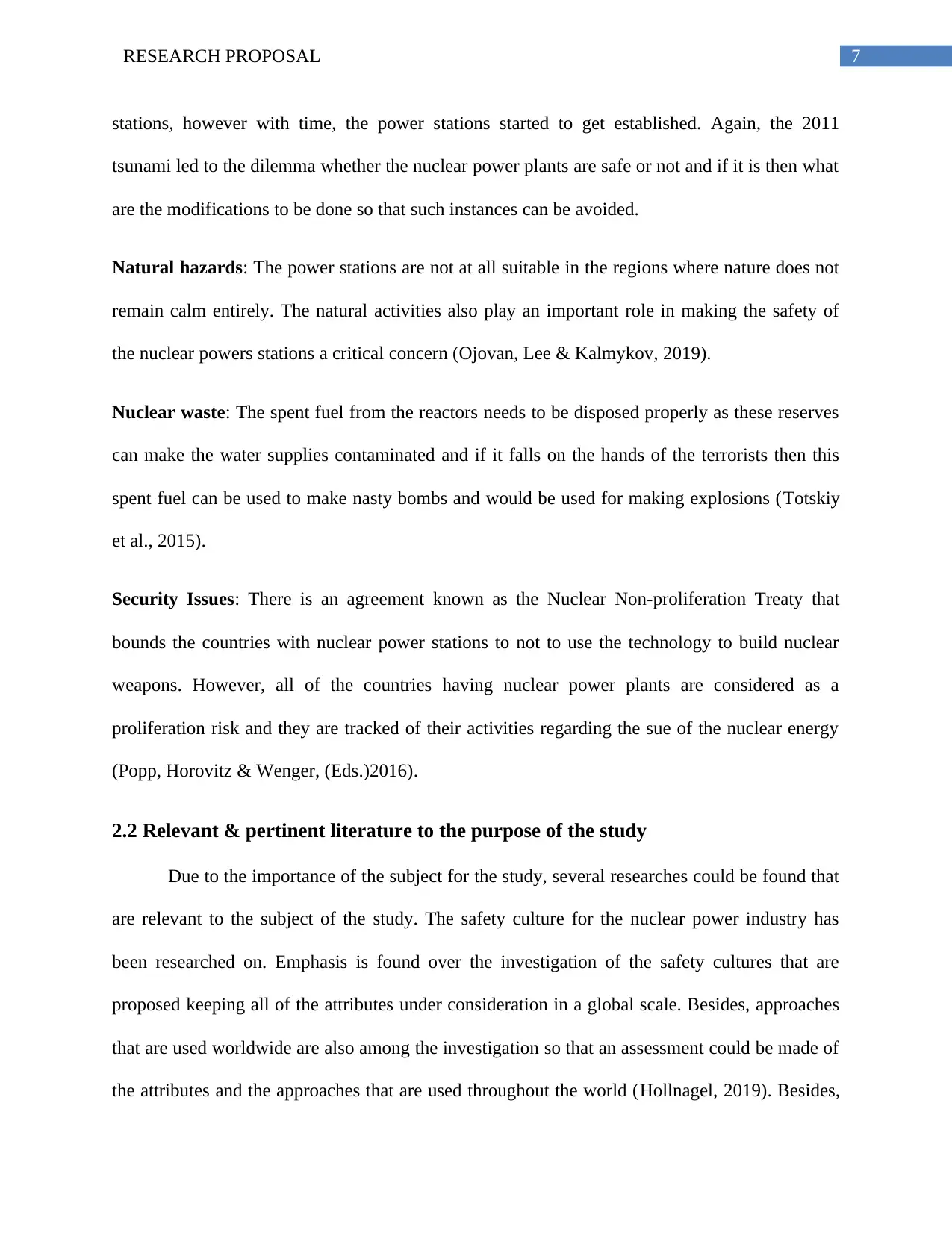
7RESEARCH PROPOSAL
stations, however with time, the power stations started to get established. Again, the 2011
tsunami led to the dilemma whether the nuclear power plants are safe or not and if it is then what
are the modifications to be done so that such instances can be avoided.
Natural hazards: The power stations are not at all suitable in the regions where nature does not
remain calm entirely. The natural activities also play an important role in making the safety of
the nuclear powers stations a critical concern (Ojovan, Lee & Kalmykov, 2019).
Nuclear waste: The spent fuel from the reactors needs to be disposed properly as these reserves
can make the water supplies contaminated and if it falls on the hands of the terrorists then this
spent fuel can be used to make nasty bombs and would be used for making explosions (Totskiy
et al., 2015).
Security Issues: There is an agreement known as the Nuclear Non-proliferation Treaty that
bounds the countries with nuclear power stations to not to use the technology to build nuclear
weapons. However, all of the countries having nuclear power plants are considered as a
proliferation risk and they are tracked of their activities regarding the sue of the nuclear energy
(Popp, Horovitz & Wenger, (Eds.)2016).
2.2 Relevant & pertinent literature to the purpose of the study
Due to the importance of the subject for the study, several researches could be found that
are relevant to the subject of the study. The safety culture for the nuclear power industry has
been researched on. Emphasis is found over the investigation of the safety cultures that are
proposed keeping all of the attributes under consideration in a global scale. Besides, approaches
that are used worldwide are also among the investigation so that an assessment could be made of
the attributes and the approaches that are used throughout the world (Hollnagel, 2019). Besides,
stations, however with time, the power stations started to get established. Again, the 2011
tsunami led to the dilemma whether the nuclear power plants are safe or not and if it is then what
are the modifications to be done so that such instances can be avoided.
Natural hazards: The power stations are not at all suitable in the regions where nature does not
remain calm entirely. The natural activities also play an important role in making the safety of
the nuclear powers stations a critical concern (Ojovan, Lee & Kalmykov, 2019).
Nuclear waste: The spent fuel from the reactors needs to be disposed properly as these reserves
can make the water supplies contaminated and if it falls on the hands of the terrorists then this
spent fuel can be used to make nasty bombs and would be used for making explosions (Totskiy
et al., 2015).
Security Issues: There is an agreement known as the Nuclear Non-proliferation Treaty that
bounds the countries with nuclear power stations to not to use the technology to build nuclear
weapons. However, all of the countries having nuclear power plants are considered as a
proliferation risk and they are tracked of their activities regarding the sue of the nuclear energy
(Popp, Horovitz & Wenger, (Eds.)2016).
2.2 Relevant & pertinent literature to the purpose of the study
Due to the importance of the subject for the study, several researches could be found that
are relevant to the subject of the study. The safety culture for the nuclear power industry has
been researched on. Emphasis is found over the investigation of the safety cultures that are
proposed keeping all of the attributes under consideration in a global scale. Besides, approaches
that are used worldwide are also among the investigation so that an assessment could be made of
the attributes and the approaches that are used throughout the world (Hollnagel, 2019). Besides,
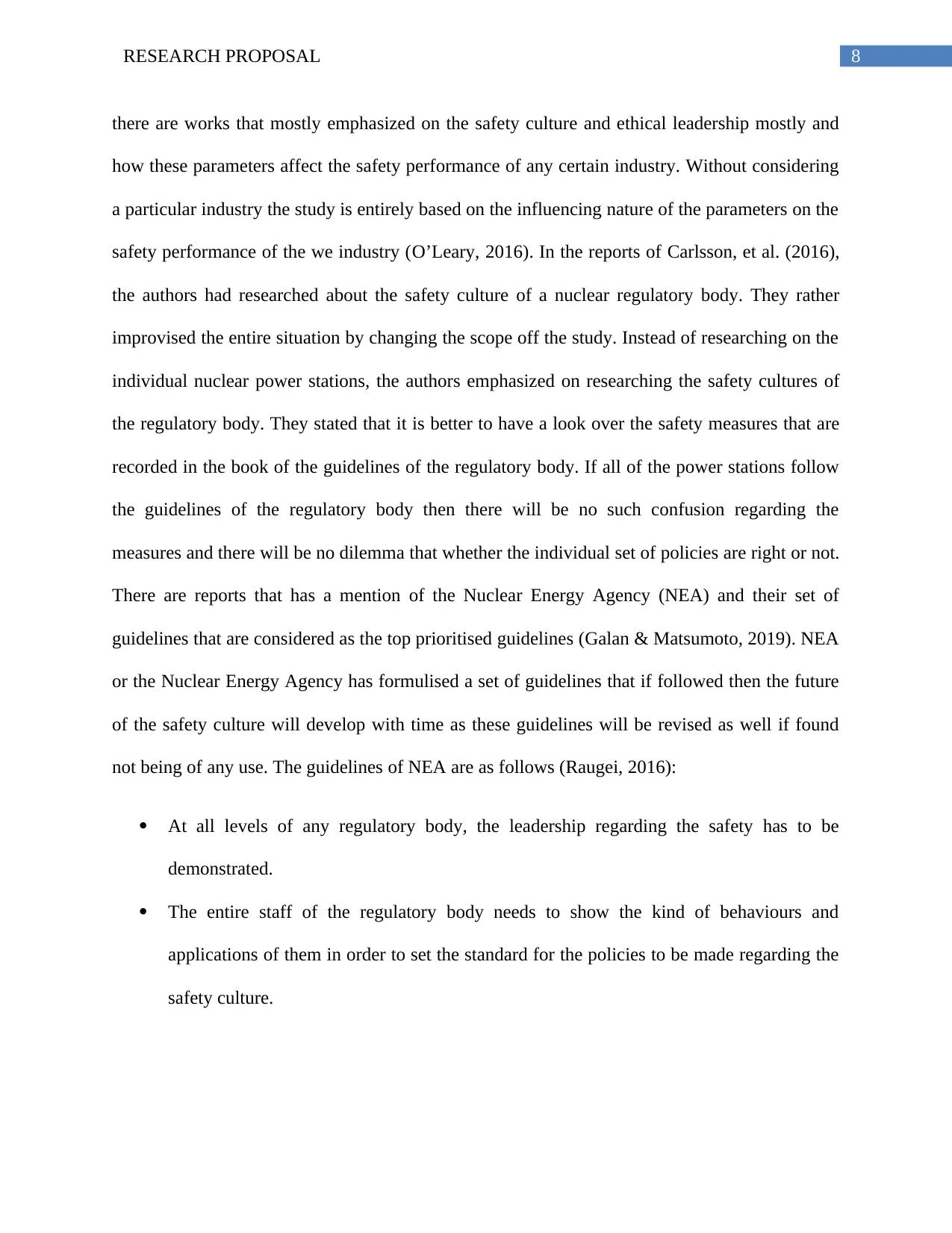
8RESEARCH PROPOSAL
there are works that mostly emphasized on the safety culture and ethical leadership mostly and
how these parameters affect the safety performance of any certain industry. Without considering
a particular industry the study is entirely based on the influencing nature of the parameters on the
safety performance of the we industry (O’Leary, 2016). In the reports of Carlsson, et al. (2016),
the authors had researched about the safety culture of a nuclear regulatory body. They rather
improvised the entire situation by changing the scope off the study. Instead of researching on the
individual nuclear power stations, the authors emphasized on researching the safety cultures of
the regulatory body. They stated that it is better to have a look over the safety measures that are
recorded in the book of the guidelines of the regulatory body. If all of the power stations follow
the guidelines of the regulatory body then there will be no such confusion regarding the
measures and there will be no dilemma that whether the individual set of policies are right or not.
There are reports that has a mention of the Nuclear Energy Agency (NEA) and their set of
guidelines that are considered as the top prioritised guidelines (Galan & Matsumoto, 2019). NEA
or the Nuclear Energy Agency has formulised a set of guidelines that if followed then the future
of the safety culture will develop with time as these guidelines will be revised as well if found
not being of any use. The guidelines of NEA are as follows (Raugei, 2016):
At all levels of any regulatory body, the leadership regarding the safety has to be
demonstrated.
The entire staff of the regulatory body needs to show the kind of behaviours and
applications of them in order to set the standard for the policies to be made regarding the
safety culture.
there are works that mostly emphasized on the safety culture and ethical leadership mostly and
how these parameters affect the safety performance of any certain industry. Without considering
a particular industry the study is entirely based on the influencing nature of the parameters on the
safety performance of the we industry (O’Leary, 2016). In the reports of Carlsson, et al. (2016),
the authors had researched about the safety culture of a nuclear regulatory body. They rather
improvised the entire situation by changing the scope off the study. Instead of researching on the
individual nuclear power stations, the authors emphasized on researching the safety cultures of
the regulatory body. They stated that it is better to have a look over the safety measures that are
recorded in the book of the guidelines of the regulatory body. If all of the power stations follow
the guidelines of the regulatory body then there will be no such confusion regarding the
measures and there will be no dilemma that whether the individual set of policies are right or not.
There are reports that has a mention of the Nuclear Energy Agency (NEA) and their set of
guidelines that are considered as the top prioritised guidelines (Galan & Matsumoto, 2019). NEA
or the Nuclear Energy Agency has formulised a set of guidelines that if followed then the future
of the safety culture will develop with time as these guidelines will be revised as well if found
not being of any use. The guidelines of NEA are as follows (Raugei, 2016):
At all levels of any regulatory body, the leadership regarding the safety has to be
demonstrated.
The entire staff of the regulatory body needs to show the kind of behaviours and
applications of them in order to set the standard for the policies to be made regarding the
safety culture.
⊘ This is a preview!⊘
Do you want full access?
Subscribe today to unlock all pages.

Trusted by 1+ million students worldwide
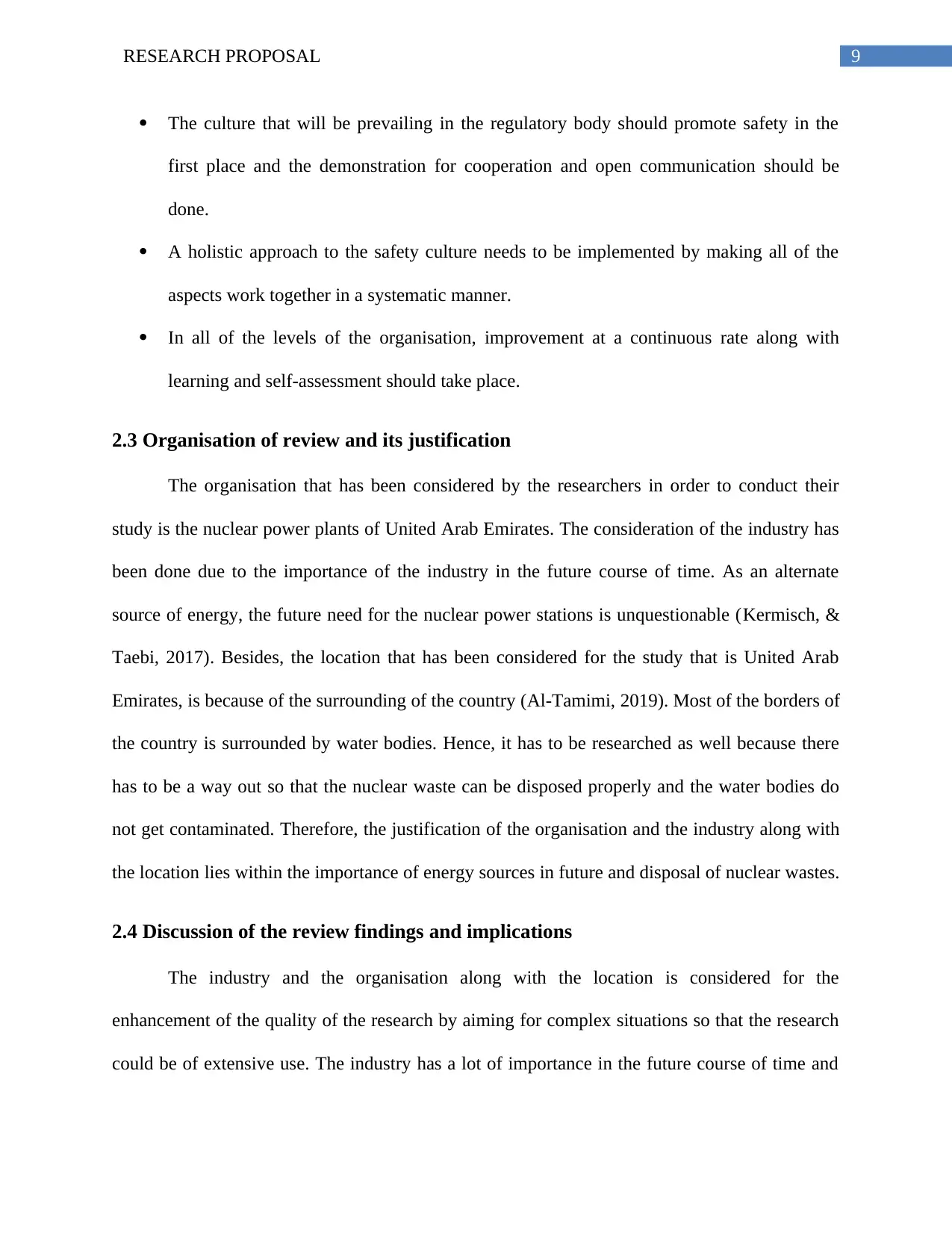
9RESEARCH PROPOSAL
The culture that will be prevailing in the regulatory body should promote safety in the
first place and the demonstration for cooperation and open communication should be
done.
A holistic approach to the safety culture needs to be implemented by making all of the
aspects work together in a systematic manner.
In all of the levels of the organisation, improvement at a continuous rate along with
learning and self-assessment should take place.
2.3 Organisation of review and its justification
The organisation that has been considered by the researchers in order to conduct their
study is the nuclear power plants of United Arab Emirates. The consideration of the industry has
been done due to the importance of the industry in the future course of time. As an alternate
source of energy, the future need for the nuclear power stations is unquestionable (Kermisch, &
Taebi, 2017). Besides, the location that has been considered for the study that is United Arab
Emirates, is because of the surrounding of the country (Al-Tamimi, 2019). Most of the borders of
the country is surrounded by water bodies. Hence, it has to be researched as well because there
has to be a way out so that the nuclear waste can be disposed properly and the water bodies do
not get contaminated. Therefore, the justification of the organisation and the industry along with
the location lies within the importance of energy sources in future and disposal of nuclear wastes.
2.4 Discussion of the review findings and implications
The industry and the organisation along with the location is considered for the
enhancement of the quality of the research by aiming for complex situations so that the research
could be of extensive use. The industry has a lot of importance in the future course of time and
The culture that will be prevailing in the regulatory body should promote safety in the
first place and the demonstration for cooperation and open communication should be
done.
A holistic approach to the safety culture needs to be implemented by making all of the
aspects work together in a systematic manner.
In all of the levels of the organisation, improvement at a continuous rate along with
learning and self-assessment should take place.
2.3 Organisation of review and its justification
The organisation that has been considered by the researchers in order to conduct their
study is the nuclear power plants of United Arab Emirates. The consideration of the industry has
been done due to the importance of the industry in the future course of time. As an alternate
source of energy, the future need for the nuclear power stations is unquestionable (Kermisch, &
Taebi, 2017). Besides, the location that has been considered for the study that is United Arab
Emirates, is because of the surrounding of the country (Al-Tamimi, 2019). Most of the borders of
the country is surrounded by water bodies. Hence, it has to be researched as well because there
has to be a way out so that the nuclear waste can be disposed properly and the water bodies do
not get contaminated. Therefore, the justification of the organisation and the industry along with
the location lies within the importance of energy sources in future and disposal of nuclear wastes.
2.4 Discussion of the review findings and implications
The industry and the organisation along with the location is considered for the
enhancement of the quality of the research by aiming for complex situations so that the research
could be of extensive use. The industry has a lot of importance in the future course of time and
Paraphrase This Document
Need a fresh take? Get an instant paraphrase of this document with our AI Paraphraser

10RESEARCH PROPOSAL
the location has an issue of disposal of the nuclear waste. Hence, the research needs to be done in
order to research and find out the remedies and plans for the following issues.
2.5 What has been learned?
It has been learned that throughout the time till today, this particular topic of study has
been researched a lot and there are various faces of the studies. The point of emphasis for the
studies varied to a great extent and there are multiple ideas that are reflected through it. The use
of the safety culture in order to increase the safety performance of the organisation is seen.
Again, the regulatory measures of the regulatory body are also been described in detail. It is
learnt that how abiding by the rulers of the regulatory body can make the development in the
safety performance of the organisation.
2.6 What are the gaps in knowledge?
Although there are several areas that are seen to be covered in the literature review
section of the paper such as safety measures that need to be formulated and should be
standardized so that all will follow the guidelines. However, the research that this particular
report deals with seems to be something that has not bee covered yet and hence, can be
considered as a gap in the knowledge. Researches are limited in the region of disposal of nuclear
waste. Although various guidelines have been demonstrated by various authors but, in actual
how to implement them has not been yet considered that much in the researches.
the location has an issue of disposal of the nuclear waste. Hence, the research needs to be done in
order to research and find out the remedies and plans for the following issues.
2.5 What has been learned?
It has been learned that throughout the time till today, this particular topic of study has
been researched a lot and there are various faces of the studies. The point of emphasis for the
studies varied to a great extent and there are multiple ideas that are reflected through it. The use
of the safety culture in order to increase the safety performance of the organisation is seen.
Again, the regulatory measures of the regulatory body are also been described in detail. It is
learnt that how abiding by the rulers of the regulatory body can make the development in the
safety performance of the organisation.
2.6 What are the gaps in knowledge?
Although there are several areas that are seen to be covered in the literature review
section of the paper such as safety measures that need to be formulated and should be
standardized so that all will follow the guidelines. However, the research that this particular
report deals with seems to be something that has not bee covered yet and hence, can be
considered as a gap in the knowledge. Researches are limited in the region of disposal of nuclear
waste. Although various guidelines have been demonstrated by various authors but, in actual
how to implement them has not been yet considered that much in the researches.
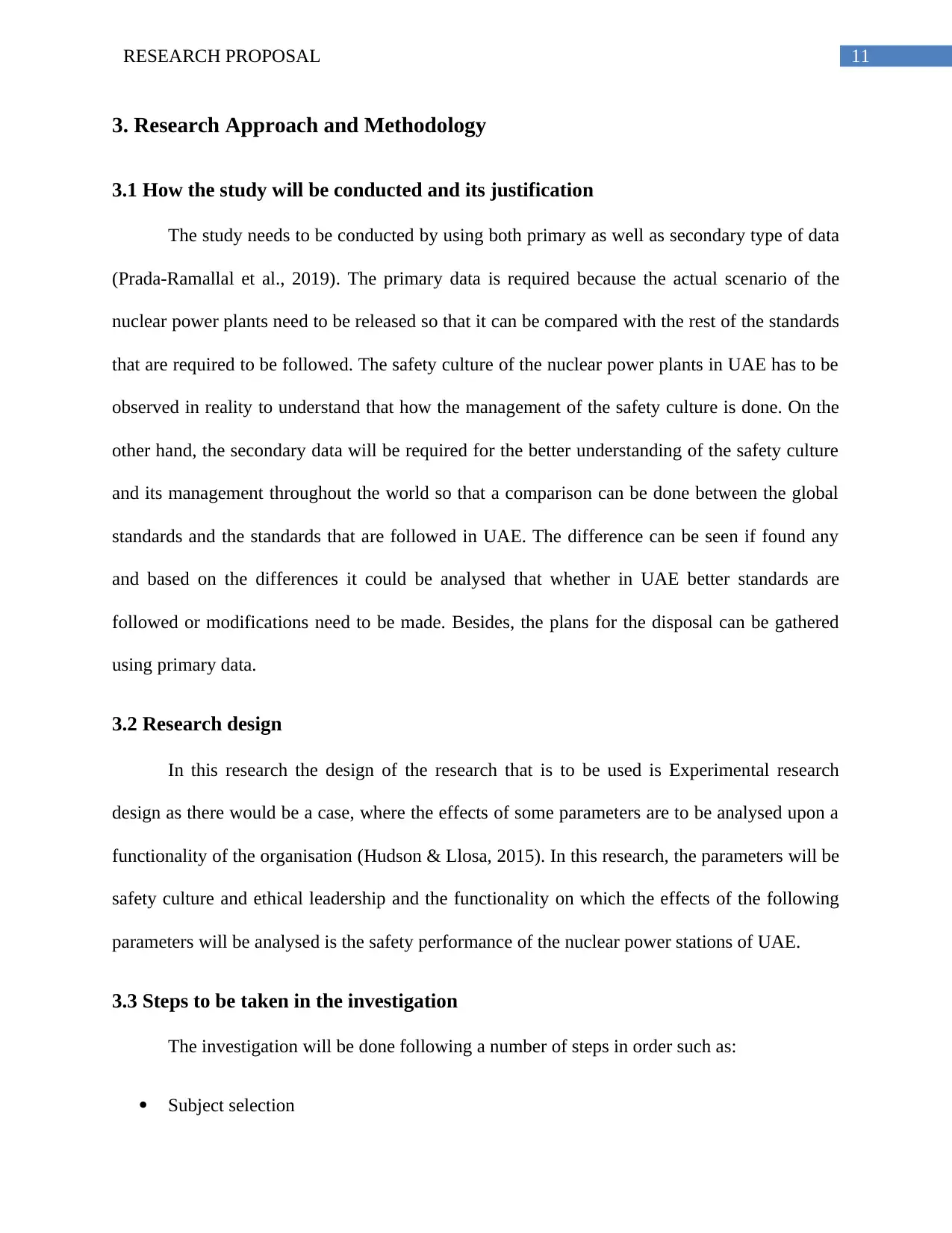
11RESEARCH PROPOSAL
3. Research Approach and Methodology
3.1 How the study will be conducted and its justification
The study needs to be conducted by using both primary as well as secondary type of data
(Prada-Ramallal et al., 2019). The primary data is required because the actual scenario of the
nuclear power plants need to be released so that it can be compared with the rest of the standards
that are required to be followed. The safety culture of the nuclear power plants in UAE has to be
observed in reality to understand that how the management of the safety culture is done. On the
other hand, the secondary data will be required for the better understanding of the safety culture
and its management throughout the world so that a comparison can be done between the global
standards and the standards that are followed in UAE. The difference can be seen if found any
and based on the differences it could be analysed that whether in UAE better standards are
followed or modifications need to be made. Besides, the plans for the disposal can be gathered
using primary data.
3.2 Research design
In this research the design of the research that is to be used is Experimental research
design as there would be a case, where the effects of some parameters are to be analysed upon a
functionality of the organisation (Hudson & Llosa, 2015). In this research, the parameters will be
safety culture and ethical leadership and the functionality on which the effects of the following
parameters will be analysed is the safety performance of the nuclear power stations of UAE.
3.3 Steps to be taken in the investigation
The investigation will be done following a number of steps in order such as:
Subject selection
3. Research Approach and Methodology
3.1 How the study will be conducted and its justification
The study needs to be conducted by using both primary as well as secondary type of data
(Prada-Ramallal et al., 2019). The primary data is required because the actual scenario of the
nuclear power plants need to be released so that it can be compared with the rest of the standards
that are required to be followed. The safety culture of the nuclear power plants in UAE has to be
observed in reality to understand that how the management of the safety culture is done. On the
other hand, the secondary data will be required for the better understanding of the safety culture
and its management throughout the world so that a comparison can be done between the global
standards and the standards that are followed in UAE. The difference can be seen if found any
and based on the differences it could be analysed that whether in UAE better standards are
followed or modifications need to be made. Besides, the plans for the disposal can be gathered
using primary data.
3.2 Research design
In this research the design of the research that is to be used is Experimental research
design as there would be a case, where the effects of some parameters are to be analysed upon a
functionality of the organisation (Hudson & Llosa, 2015). In this research, the parameters will be
safety culture and ethical leadership and the functionality on which the effects of the following
parameters will be analysed is the safety performance of the nuclear power stations of UAE.
3.3 Steps to be taken in the investigation
The investigation will be done following a number of steps in order such as:
Subject selection
⊘ This is a preview!⊘
Do you want full access?
Subscribe today to unlock all pages.

Trusted by 1+ million students worldwide
1 out of 22
Related Documents
Your All-in-One AI-Powered Toolkit for Academic Success.
+13062052269
info@desklib.com
Available 24*7 on WhatsApp / Email
![[object Object]](/_next/static/media/star-bottom.7253800d.svg)
Unlock your academic potential
Copyright © 2020–2025 A2Z Services. All Rights Reserved. Developed and managed by ZUCOL.





